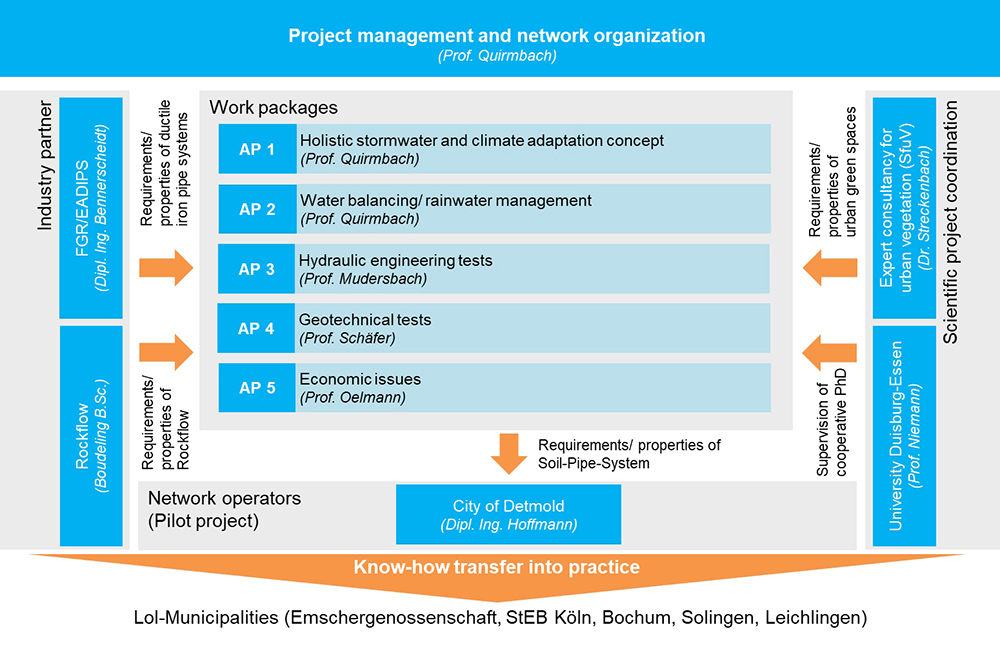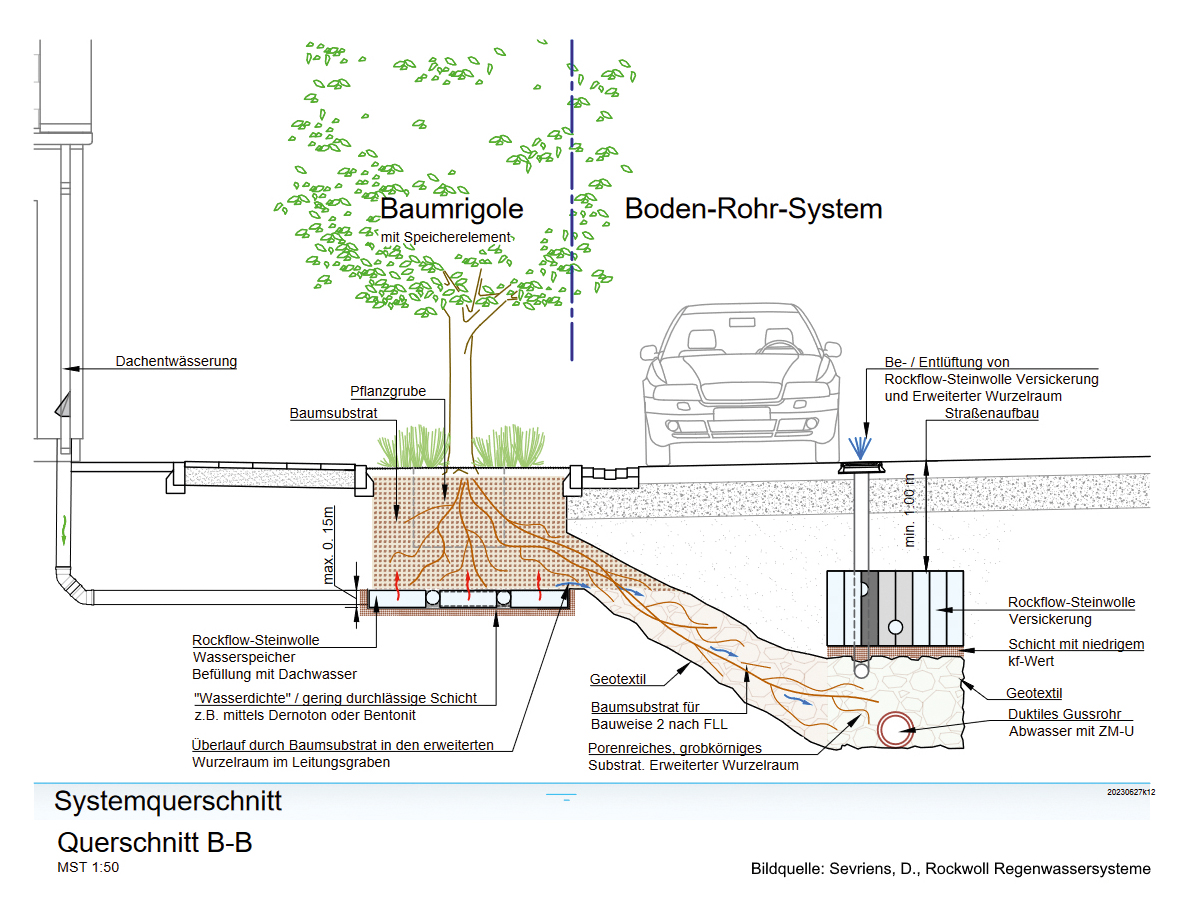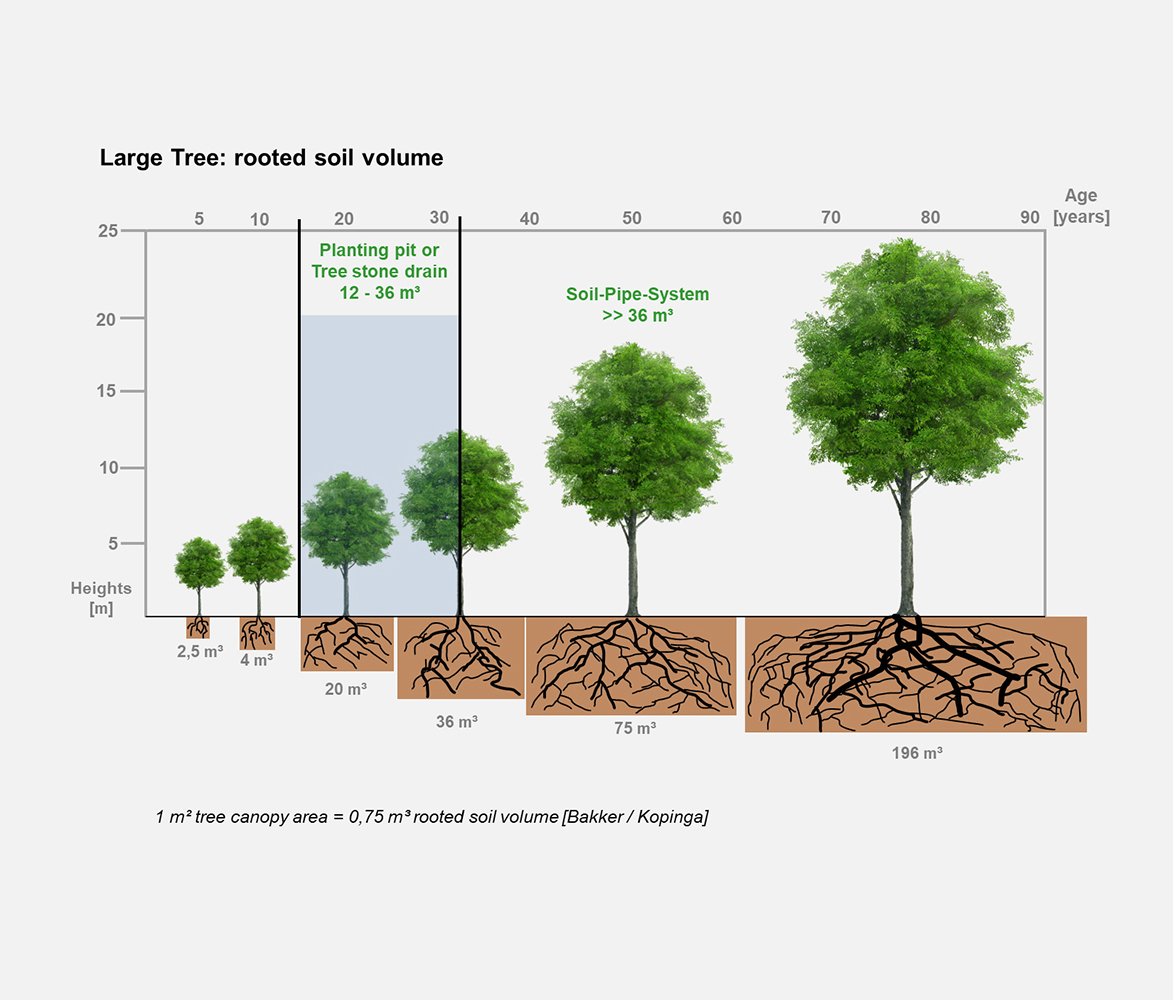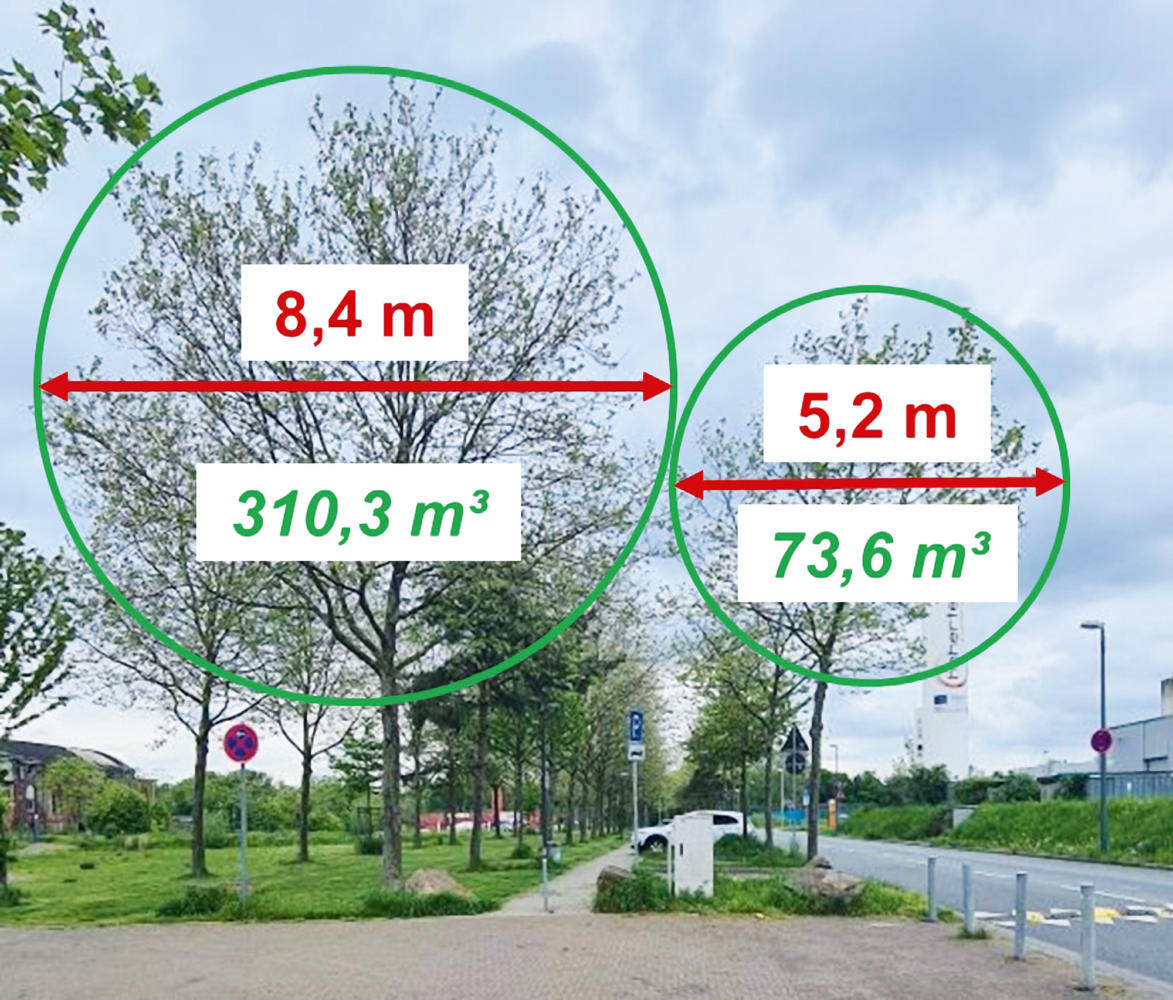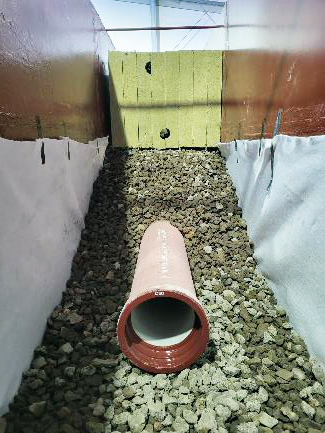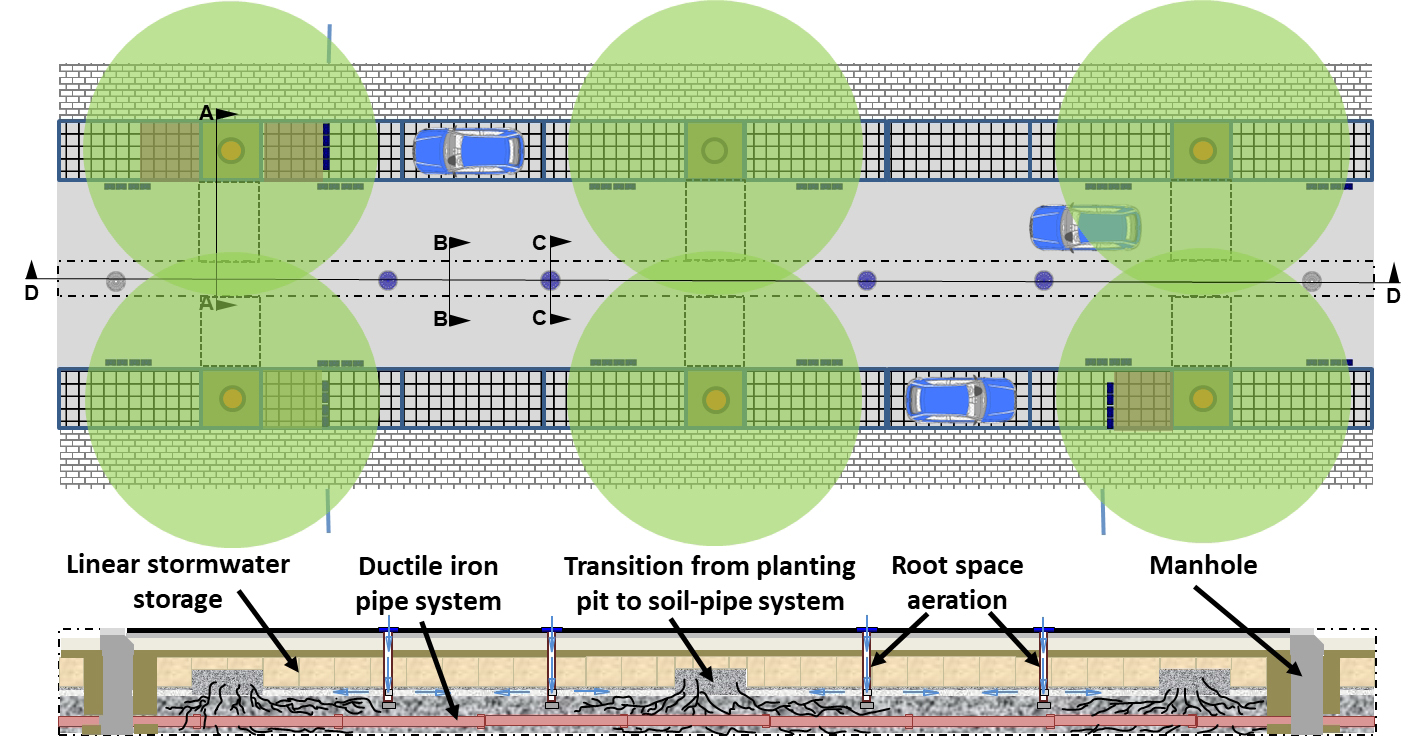The BoRSiS soil-pipe system
A sponge city element in the street space
Despite many efforts to slow down man-made climate change and limit global warming to below 2 °C, ideally even to 1.5 °C above pre-industrial levels, climate change continues unabated. Against this backdrop, the implementation of measures to adapt to the consequences of climate change is becoming increasingly important. Cities in particular are facing major challenges. Prolonged periods of heat combined with periods of drought on the one hand and heavy rainfall events on the other require modified strategies for the planning, construction and operation of urban infrastructures. While solutions on the surface, such as the identification of surface flow paths and the design of rainwater retention areas on the surface, have found their way into water management practice, a major challenge is to incorporate urban greenery as a climate adaptation element.
Joint solutions for rainwater and vegetation are at the centre of consideration under the keyword “sponge city”. The projects relating to “tree-rigs” show, based on the position paper on water-sensitive street design [1] of the Grünflächenamtsleiterkonferenz (GALK), that finding solutions can be fraught with conflict. In principle, solutions should be sought that offer more space for roots on the one hand and more space for rainwater on the other. There is great potential for this by incorporating underground elements in the street space for adaptation measures. Against this background, the soil-pipe system research and development project launched on 1 October 2021 can be classified as an innovative element of climateadjusted urban drainage (BoRSiS). The objective of the project is to develop an innovative and practical construction method for the storage and infiltration of rainwater and for the irrigation of urban trees. In this way, two key aspects of climate change adaptation measures are considered together.
On the one hand, the construction method provides a storage area for rainwater during (heavy) rainfall, and on the other hand, it makes the stored rainwater available to the trees for evaporation with a time delay. The use of pipe trenches provides an extended linear storage area for rainwater as well as a root trench connecting tree sites without the need for additional surface area. Another focus is on the use of circular products.
The project structure
The interdisciplinary collaboration between water management experts, geotechnical engineers, economists, tree experts and industrial partners is developing a holistic, innovative approach, the practical implementation of which will contribute to solving important social problems that arise as a result of climate change. As shown in Fig. 1, the work is divided into five work packages (WP). The holistic heavy rainfall and climate adaptation concept represents the overarching framework of this project. The other WPs will analyse specific relevant issues and develop solutions that will be integrated into the overall concept:
- WP 1 and 2 are covered by the Department of Urban Water Management at the Institute of Civil Engineering of the University of Applied Sciences Ruhr West. In the work packages, a holistic heavy rain and climate adaptation concept as well as a water balance will be developed.
- The hydraulic engineering investigations located in WP 3 are covered by a test stand at Bochum University of Applied Sciences.
- In WP 4, geotechnical investigations are covered by the Institute of Civil Engineering at the Ruhr West University of Applied Sciences in the Geotechnics Department.
- The Institute of Economics at the Ruhr West University of Applied Sciences is dealing with the economic issues of the project in WP 5.
- The Expert Office for Urban Vegetation is closely supporting all WPs in the design, implementation of the trials, development of recommendations for action and in the preliminary planning of the pilot project. This ensures that no tree-ecological planning errors are investigated and implemented in all phases of the project.
- The city of Detmold, as the user, will specify the concrete framework conditions for the subsequent real implementation in a pilot project and provide the corresponding data material. Further concrete pilot projects are planned in Cologne and Leichlingen. In addition, Letters of Interest (LOIs) have also been received from the cities of Solingen, Wuppertal and Düsseldorf.
The project is scheduled to run until September 2024. It is financed by the industry partners EADIPS®/FGR® e. V. [2] and ROCKWOOL Rainwater Systems [3] as well as by funding from the German Federal Ministry of Education and Research (BMBF) under the funding programme “Research at Universities of Applied Sciences” with the funding code 13FH002KA0.
The soil-pipe system
The soil-pipe system focuses on the properties of the bedding and backfill materials used in the pipe trenches, combined with a robust pipe system made of circular materials and a circular trench system (see [4]). In this way, the pipe trenches can be used to store rainwater and provide additional root space for urban trees without creating additional competition for space on the surface or in the already intensively used pavement area.
In order to use the previously unused pipe trench for rainwater storage and root space, a change in practice is required:
- At present, the materials used to backfill the trenches are only selected so that they can be compacted very well to ensure a stable bedding for the pipes.
- Roots should be kept away from the pipe trench, e.g. by using low-porosity backfill materials (see [5]) as a protective measure against root ingrowth.
- The discharge of rainwater into the pipe trench is not intended..
The elements used in the soil-pipe system to design the root space are based on DWA-M 162 “Tree locations, sewers and pipes” [5]. This describes two different measures for organising the interaction between tree roots and the elements of the underground infrastructure. A distinction is made between passive and active protective measures for the protection of underground infrastructure elements:
- Passive protection measures
are those taken in the immediate vicinity of underground pipes or pipe trenches. The most suitable time is when new underground pipes are being constructed, as no separate road excavation is required. The choice of protective measures depends on local conditions [5]. Passive protection measures listed and used for the soil-pipe system include root resistant pipe joints. - Active protection measures
are those taken in the immediate vicinity of the tree or planting pit. They are best applied when planting new trees. The choice of protective measure should depend on local conditions and in particular the location of neighbouring underground pipelines [5]. One listed active protection measure is root trenches, which serve to guide roots outside the planting pit, e.g. to other areas through which roots can grow. Favourable vegetation conditions are created for this purpose.
A rockwool infiltration trench (Rockflow) is placed above the root zone to store rainwater.
How the soil-pipe system works
By delaying the release of rainwater from the rainwater storage above the root zone, trees can be watered even during long periods of drought. To achieve this, the roots of existing or newly planted trees are encouraged to grow towards the root chamber in the pipe trench using vegetation engineering techniques. The position of the soil-pipe system in the street space and the spread of the root system is shown as an example in Fig. 2. It is also possible and desirable to connect tree trenches and enlarge the root spaces (see Fig. 3).
The combination of irrigation and increased root space will improve the vitality, growth conditions and life expectancy of trees in urban areas. Vigorous and large trees have a positive effect on the urban climate, helping to minimise urban heat islands through water evaporation and the provision of shade. They are also expected to reduce the need for maintenance, such as watering trees with potable water during dry periods.
Root spaces for urban trees
The influence of the available root space on the growth of the aboveground parts of urban trees must be considered separately. This relationship is illustrated in Fig. 4. The illustration, which is not to scale, is based on a calculation approach by J.W. Bakker and J. Kopinga to estimate the maximum root space on the basis of the projected crown area. In addition, the minimum planting pit size according to FLL (12 m³) [7], the planting pit size according to ZTV-Vegtra-Mü (24 m³) [8] or for tree trenches [9] and the soil-tube system are shown. The correlation is very simple. The larger the rootable soil, the larger the crown volume. In addition to the cooling effects of evaporation and shading through improved urban greening, the quality of life increases [10]. Trees also help to maintain biodiversity [11].
The differences in the growth behaviour of two trees planted at the same time are shown in Fig. 5. While the root space of the tree shown on the right is restricted by neighbouring footpaths, a car park and a road, the roots of the tree on the left can develop better in the green space.
Robustness and root resistance of pipe systems
Ductile cast iron pipe systems are a core element of the soil-pipe system. In particular, their robust mechanical properties in combination with root-resistant pipe joints ensure safe operation even under the changing conditions described above.
Ductile cast iron pipe systems are standardised in the European Standardisation Committee CEN / TC 203 ‘Cast iron pipes, fittings and their joints’. The members of the committee began at an early stage to further develop the standards in the direction of sponge city applications. This was also done against the background of a Europe-wide implementation of the ductile iron pipe construction method to be developed as part of the BoRSiS project. The following standards are currently being revised, finalised or developed:
- EN 15542 [12] for the cement mortar coating of ductile iron pipes is under revision.
- prEN 17970 [13] describes for the first time a test method for verifying the root resistance of plugged and diffusion-tight pipe joints.
The development of a technical code of practice for sponge city applications has been included in the work programme of TC 203. The results of the project described here will feed directly into the regulations to be developed.
The soil-pipe system in the street space
Fig. 6 illustrates the basic structure of the soil-pipe system in the street space with a cross-section, top view and longitudinal section. The figure also serves as a basis for discussion for the planning and construction of pilot measures in the project partner city of Detmold and in the cities of Cologne and Leichlingen. In addition to construction and vegetation- related issues, questions regarding the pre-treatment of the rainwater discharged, the storage capacity of the rock wool, the reduction of the storage space in the root zone due to root growth, water law approvals and the long-term operation of the soil-pipe system are discussed intensively, particularly during on-site meetings and project meetings.
The willingness to work together to find solutions to the increasingly urgent challenges posed by the effects of climate change was evident throughout the discussions.
Summary
The research and development project “Soil-pipe system as an innovative element of climate-adjusted urban drainage (BoRSiS)”, which was launched on 1 October 2021, is currently in the final third of the project and is expected to be completed on 30 September 2024 after a three-year term. The results achieved so far are very promising.
The use of the otherwise unused space in the trench of the sewer trench offers the opportunity to create both an extended root space (>> 36 m³) and a similarly large reservoir for rainwater. When the system is implemented, sufficient root space can be provided for existing trees and also for new plantings. This offers opportunities for vital trees in times of climate change. The rainwater storage tank, located above the root zone for irrigation, also ensures a water supply during prolonged droughts. The pilot applications currently being planned in Detmold, Cologne and Leichlingen will serve to further develop the design of the soil-pipe system in detail. The accompanying further development of the regulations for ductile iron pipe systems in CEN TC 203 will serve to facilitate the realisation of the construction method on site.
Author:
Christoph Bennerscheidt

